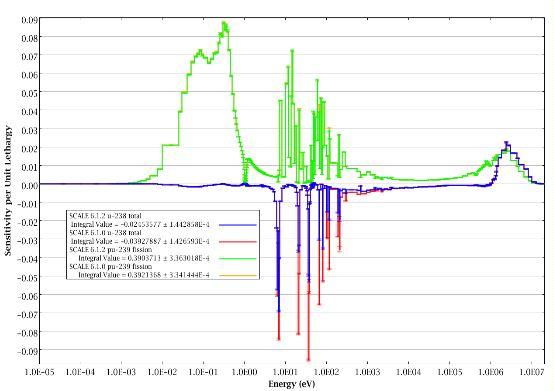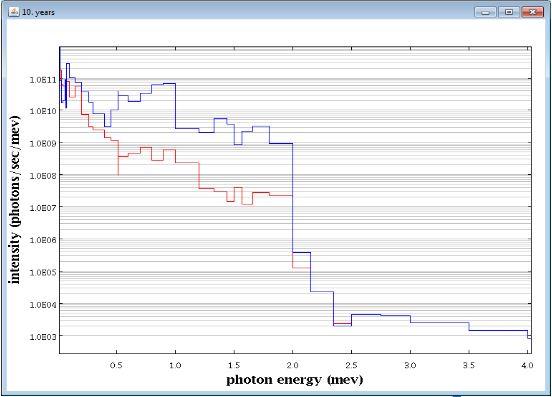This release of SCALE is unsupported. Please click here for the current production release.
The identified issues in SCALE 6.1.2 are presented below, along with suggested user approaches to overcome existing limitations.
Critical Spectrum Calculations with NEWT
Corrected in SCALE 6.1.2
An issue was identified in NEWT that causes few-group homogenization calculations to fail in critical spectrum mode when using the user specified critical buckling value or critical height. There is currently no workaround for this issue, but it will be corrected in the pending SCALE 6.1.2 patch.
Date Identified: 01/31/2013
ORIGEN Irradiation Calculations
Corrected in SCALE 6.1.2
An issue in ORIGEN for irradiation calculations that will occasionally cause large masses fission products to be produced from non-fissile materials. This error only affects SCALE 6.1 (and 6.1.1) calculations with time steps of 5-35 days. When the error is encountered and hydrogen exists in the system, large masses of fission products with A>162 are produced (~1E8 grams) and are easily identified. When hydrogen does not exist in the system, the error may be more difficult to detect as it only affects the transitions for a small set of fission products with A>162. Users can work around this issue by modify the time steps, and it will be corrected in the pending SCALE 6.1.2 patch.
Date Identified: 11/25/2012
Possible Inaccurate Implicit Sensitivities with TSUNAMI
Corrected in SCALE 6.1.2
An error has been identified that affects some TSUNAMI sensitivity analysis calculations where implicit sensitivities for some nuclides may not be accurately computed. The issue was found in BONAMIST, used to generate the implicit sensitivity data, when examining a MOX pin-cell benchmark. The error has been observed to impact the sensitivity for U-238 in this test case, but has not been show to impact critical experiments or realistic application systems. Users who performed recommended direct perturbation calculations would observe the discrepancy in any previous calculations. This issue will be corrected in the SCALE 6.1.2 patch. A possible user workaround for this issue is to change the order of nuclides in the input read compositions data block.
For the MOX fuel pin test case, the following results were observed with a significant difference in the U-238 implicit contribution leading to a significant change in the sensitivity coefficient. As show in the figure below, the differences occur in the resonance region for U-238, but Pu-239 is largely unaffected.
Sensitivity of keff to U-238 Total Cross Section for MOX Fuel Pin Test Case


A more typical result is shown below for critical experiment MIX-COMP-THERM-001-001, where only small differences are observed.
Sensitivity of keff to U-238 Total Cross Section for MIX-COMP-THERM-001-00

Possible Incorrect Selection of an Axial Burnup Profile in STARBUCS Burnup Credit Criticality Calculations
STARBUCS has the option to use axial burnup profiles that are dependent on assembly average burnup and provides three default axial burnup profiles (i.e., the NAX=-18 input option) applicable to an assembly averageburnup as follows: (1) burnup less than 18 GWd/MTU; (2) burnup greater than or equal to 18 GWd/MTU and less than 30 GWd/MTU; and (3) burnup greater than or equal to 30 GWd/MTU. It has been noticed that for assembly average burnup values at which the axial burnup profile changes (i.e., 18 and 30 GWd/MTU in the case of the STARBUCS default burnup profiles), and depending on the number of libraries per cycle (NLIB) provided in the burnup history data or in the search parameter data, STARBUCS may select an incorrect burnup profile. For the search parameter data block specification: POWER=50.0 NLIB=7 BU=30, STARBUCS may select the axial burnup profile that is applicable to the burnup range [18 – 30) GWd/MTU in place of the axial burnup profile that is applicable to an assembly average burnup of 30 GWd/MTU. This problem is caused by a rounding error, which will be corrected in a future release. Currently, the STARBUCS internal calculation NLIB*BU/NLIB does not always produces the required precision for the assembly average burnup values of 18 and 30 GWd/MTU to enable the selection of the intended axial burnup profile. To avoid this error, the assembly average burnup values being used as the boundaries for the burnup intervals that define different axialburnup profiles should be increased by a very small amount. For example, if the assembly average values for loading curve analyses are 18 and 30 GWd/MTU, the following input specifications in the read search data block produce correct selection of the intended default axial burnup profiles:
POWER=50.0 NLIB=7
BU=17.999 18.001 29.999 30.001 end
Note that the STARBUCS output file provides information about the axial burnup profile selected for an average assembly burnup value, such as:
axial profile from database
assembly avg burnup 18.000 gwd/mtu, profile 2
Date Identified: 8/5/2012
Error in ENDF/B-VII.0 Decay Data
Corrected in SCALE 6.1.2
An error in the nuclear decay data for 234Th has been identified in ENDF/B-VII.0, which is used for the SCALE decay library. A review of the problem indicates that the error was introduced in the evaluated ENDF/B-VII.0 decay sub-library released by the National Nuclear Data Center (NNDC) in December 2006. The NNDC has confirmed the problem and recently released an updated decay library with ENDF/B-VII.1. Currently, ORNL is working closely with NNDC to identify the nature and extent of the nuclear data evaluation problem and is preparing a patch for the ENDF/B-VII.0-based decay library distributed with SCALE 6.1. It is important to note that ORNL has performed extensive validation using the ENDF/B-VII.0-based decay library in SCALE 6.1 and has NOT identified any discrepancies for benchmark problems involving irradiated fuel isotopic compositions, decay heat, and source terms. The error has been observed for problems involving the decay of 238U. As an example, the gamma ray spectra calculated using SCALE 6.0 (ENDF/B-VI decay data) and SCALE 6.1 (ENDF/B-VII.0 decay data) are shown in the figure below. The spectrum obtained using ENDF/B-VII.0 data is significantly over estimated, caused primarily by incorrect production of 234Pa from 234Th decay. Additional information on the error in ENDF/B-VII.0 and decay evaluation improvements for ENDF/B-VII.1 are posted on the NNDC website.

Date Identified: March 18, 2012

